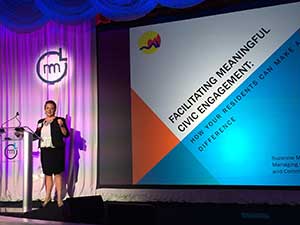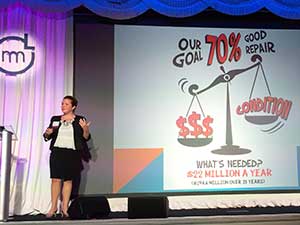 The League’s 2016 Convention on Mackinac Island got off to a great start with Suzanne Schulz’ energetic presentation on Facilitating Meaningful Civic Engagement: How Your Residents Can Make a Difference. Schulz, Grand Rapids’ managing director of design, development and community engagement, says that government is no longer a vending machine that can give voters everything they want all the time. That makes community engagement critically important. Local government and residents have to work together to figure out how to improve their communities with limited resources.
The League’s 2016 Convention on Mackinac Island got off to a great start with Suzanne Schulz’ energetic presentation on Facilitating Meaningful Civic Engagement: How Your Residents Can Make a Difference. Schulz, Grand Rapids’ managing director of design, development and community engagement, says that government is no longer a vending machine that can give voters everything they want all the time. That makes community engagement critically important. Local government and residents have to work together to figure out how to improve their communities with limited resources.
How do community leaders facilitate that community engagement? Schulz says that the more you engage citizens and understand their values, the easier it becomes to work toward common community improvement goals. Making citizens an important part of the process comes with benefits on both sides of the equation. If invited to participate, many residents will rise to the challenge. They’ll start to remember successes and how their values and vision were honored. And involving citizens at the beginning of a project is faster, easier, and more cost-effective. Otherwise, if residents get wind of community plans made without their input, the city may have to backtrack and put in a lot more time and effort to address community concerns.
Listening is one of the key skills that local governments need to employ in community engagement. It’s great to have expert data on which to develop solutions to local issues, but listening to your residents and learning their ideas is equally important. Green Grand Rapids is an example of that. This initiative brought together a number of issues under one umbrella: ash bore tree problem, school closings, restoring the rapids, bike lanes, and urban agriculture. Citizens input was gathered through games and other fun activities. One game asked people where more street trees were needed, and their responses matched up perfectly with the expert data. Green Grand Rapids resulted in $15 million in investment in trees, parks, trails, bike lanes, and restoring the rapids. Citizens felt truly engaged because they had help shape the process from the very beginning.
 Inclusion is also vital to successful community engagement. It’s important to reach out to people in all avenues of your community. Grand Rapids took great care to be very inclusive with its Sustainable Streets Task Force. A broad group of community stakeholders worked together to determine a workable road plan for the future. They began by asking residents which streets they did and didn’t like and, not surprisingly, they liked the streets that had recently been redone as complete streets. From there, the task force created a vision of attractive, safe, accessible streets that contribute to the livability of neighborhoods and the economic prosperity of business districts. Although the committee initially wanted 100 percent of city streets to be in good repair, they soon realized that the economic reality made 70 percent a more attainable goal. The members of the task force were so committed to the project that they eagerly educated their fellow residents on the city’s road challenges and how the ballot initiative would address them. The ballot initiative passed by a 2/3 margin!
Inclusion is also vital to successful community engagement. It’s important to reach out to people in all avenues of your community. Grand Rapids took great care to be very inclusive with its Sustainable Streets Task Force. A broad group of community stakeholders worked together to determine a workable road plan for the future. They began by asking residents which streets they did and didn’t like and, not surprisingly, they liked the streets that had recently been redone as complete streets. From there, the task force created a vision of attractive, safe, accessible streets that contribute to the livability of neighborhoods and the economic prosperity of business districts. Although the committee initially wanted 100 percent of city streets to be in good repair, they soon realized that the economic reality made 70 percent a more attainable goal. The members of the task force were so committed to the project that they eagerly educated their fellow residents on the city’s road challenges and how the ballot initiative would address them. The ballot initiative passed by a 2/3 margin!
To be successful at engaging your residents, it’s important to keep these things in mind:
- Believe the public’s voice has value
- Believe that the wisdom of the group is greater than your own
- Trust the process
- ]Respect and honor input – be humble
- Focus on collective leadership
- Use an iterative process; build on what you’ve learned
- Be flexible
People are willing to invest their time and effort if you do all these things, says Schulz. They have wisdom, they know their community.
